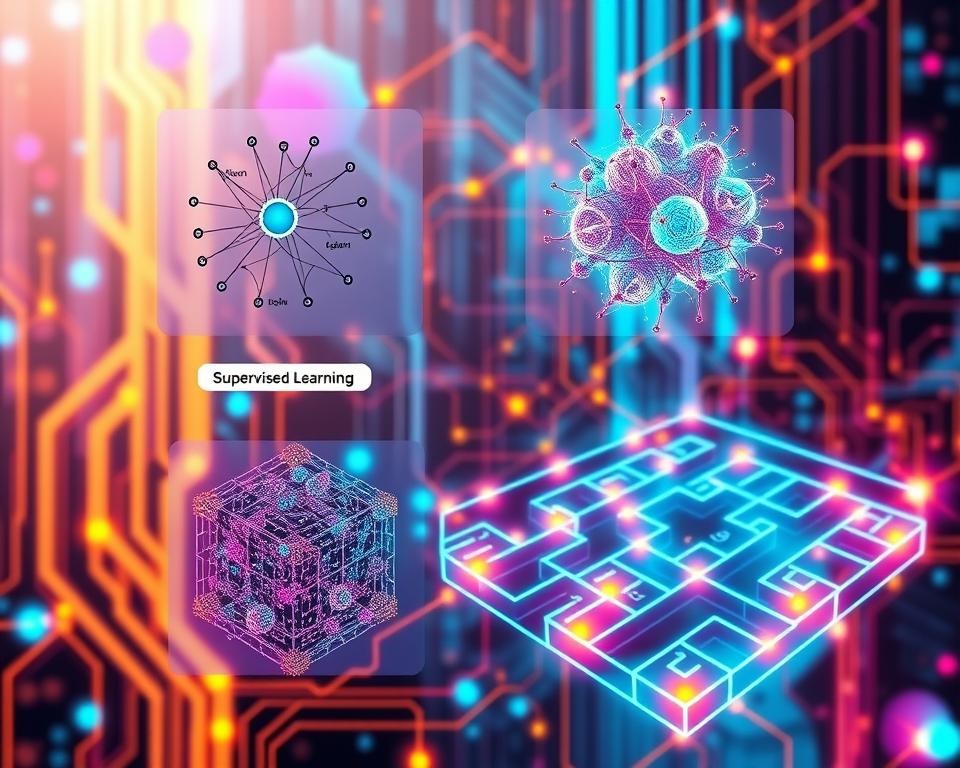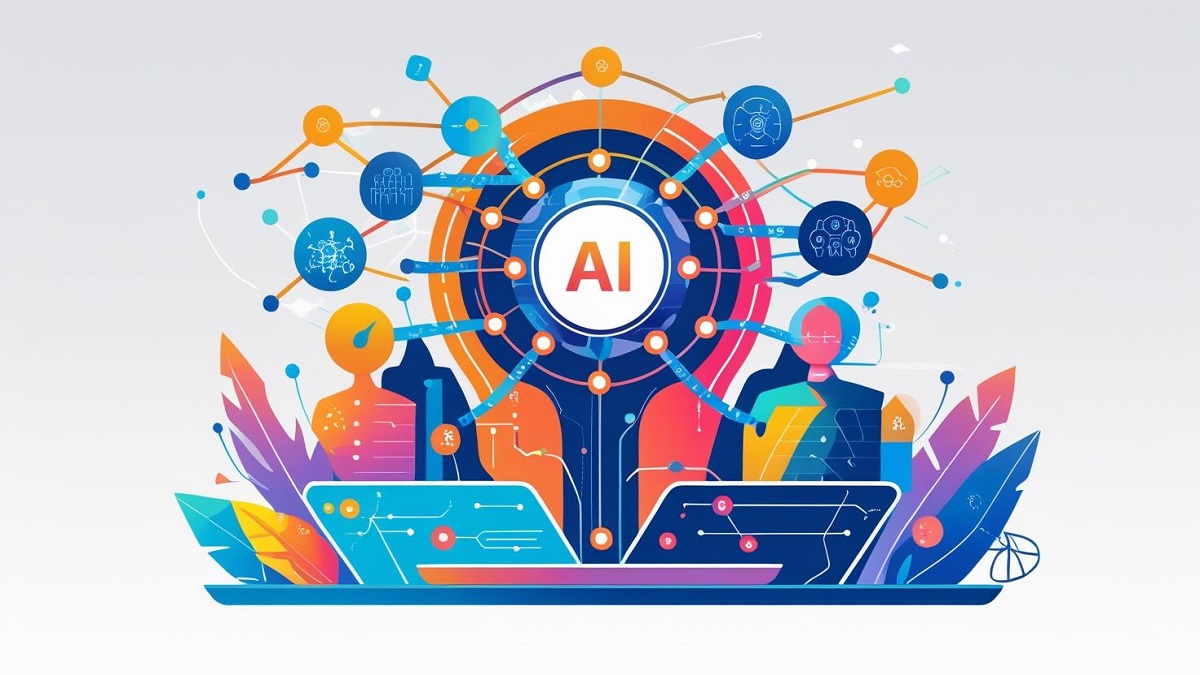Ever wondered how machines can learn and make choices on their own? In this article, we’ll explore the three main types of machine learning: supervised, unsupervised, and reinforcement learning. These concepts open up new possibilities that can change industries, solve big problems, and shape the future. But first, let’s ask a question: What if machines could learn and adapt like humans, without needing to be programmed? Curious? Let’s dive into the exciting world of machine learning together.
Key Takeaways
- Discover the fundamental differences between supervised, unsupervised, and reinforcement learning algorithms.
- Understand how each type of machine learning is applied to solve real-world problems.
- Explore the unique strengths and limitations of the three machine learning approaches.
- Learn how machine learning is transforming industries and shaping the future of technology.
- Gain insights into the latest trends and innovations in the field of machine learning.
What is Machine Learning?
Machine learning is a field of artificial intelligence that lets computers learn and get better over time. They do this without being told exactly what to do. This field uses algorithms and statistical models to help machines do tasks well. It opens up new possibilities in many industries.
Understanding the Fundamentals of Machine Learning
At its heart, machine learning is about looking at data, finding patterns, and making predictions. Machines get better at this over time, learning from new data. It combines math, computer science, and statistics, making it a powerful tool for innovation.
The Importance of Machine Learning in Today’s World
In today’s world, machine learning is very important. It helps with everything from personalized ads to self-driving cars. It’s changing how we live, work, and interact with each other.
Machine learning makes complex tasks easier and helps find important insights. It’s a key tool for businesses of all sizes. As data gets bigger and more complex, knowing machine learning basics is more important than ever.
For business leaders, data scientists, or anyone interested in tech, learning about machine learning is a must. It’s the first step to using its huge potential. Let’s dive into this exciting field and see how it’s changing our world.
Supervised Learning: Learning from Labeled Data
Supervised learning is a key part of machine learning. It uses labeled data to train algorithms. This means the data has answers, helping the model learn how to predict new data.
There are two main tasks in supervised learning: classification and regression. Classification predicts things like spam emails. Regression predicts numbers, like stock prices or hospital stays.
Popular supervised learning algorithms include linear regression and decision trees. These algorithms find patterns in data. They make accurate predictions on new data.
Supervised learning is used in many fields. It helps predict customer behavior and diagnose diseases. It’s a key tool for making decisions based on data.
“Supervised learning is the workhorse of modern machine learning, powering a wide range of real-world applications.”
Knowing about supervised learning is important. It helps in many fields, from business to healthcare. It’s essential for using machine learning effectively.
Unsupervised Learning: Finding Patterns in Unlabeled Data
Supervised learning uses labeled data to train models. But unsupervised learning finds hidden patterns in unlabeled data. It uses clustering and dimensionality reduction to uncover insights without labels.
Clustering Algorithms in Unsupervised Learning
Clustering is a key unsupervised learning technique. It groups similar data points together. This helps identify natural groups or segments in the data.
Businesses can use this to segment markets, create customer profiles, and detect anomalies. Understanding the data’s structure helps make better decisions and tailor strategies.
Popular clustering algorithms include K-means, DBSCAN, and hierarchical clustering. Each has its own strengths and weaknesses. The right algorithm depends on the data and analysis goals.
| Clustering Algorithm | Description | Advantages | Limitations |
|---|---|---|---|
| K-means | Partitions data into K distinct clusters based on proximity to centroids. | Simple, efficient, and easy to implement. | Requires specifying the number of clusters in advance, and can be sensitive to outliers. |
| DBSCAN | Density-based algorithm that identifies clusters based on density of data points. | Can handle arbitrary-shaped clusters and is robust to outliers. | Requires setting two hyperparameters, which can be challenging to tune. |
| Hierarchical Clustering | Builds a hierarchy of clusters by merging or splitting data points based on their proximity. | Provides a dendrogram visualization to help determine the optimal number of clusters. | Computationally expensive for large datasets and can be sensitive to noise. |
Using unsupervised learning techniques, organizations can find hidden patterns. They can segment their customer base and make strategic decisions based on insights.
“Unsupervised learning algorithms are the explorers of the data world, unearthing insights that would other wise remain buried.”
Reinforcement Learning: Learning through Trial and Error
Reinforcement learning is a special way of learning for machines. It’s different from supervised and unsupervised learning. Instead of using labeled data or finding patterns, it learns by interacting with its environment and getting feedback.
This method is all about finding the best actions to get the most rewards. It’s great for tasks that need smart decision-making, like playing games, robotics, and business processes.
Reinforcement learning algorithms mimic an environment, take actions, and see the results. They adjust their choices based on the feedback they get. This way, they learn which actions lead to the best outcomes.
One big plus of reinforcement learning is its ability to adapt to changing environments. It doesn’t need labeled data like supervised learning does. This makes it flexible and good at solving real-world problems where the best solution isn’t clear.
Reinforcement learning is an exciting and growing field in machine learning. It has many uses across different industries. By using trial-and-error learning, it helps organizations make better decisions, improve their processes, and innovate.
| Reinforcement Learning | Supervised Learning | Unsupervised Learning |
|---|---|---|
| Learns through interaction with an environment, receiving feedback in the form of rewards or penalties | Learns from labeled data, aiming to predict or classify new data | Discovers patterns and structures in unlabeled data without specific goals |
| Focuses on finding the optimal sequence of actions to maximize cumulative reward | Builds models to predict or classify new data based on the labeled training data | Identifies groups, clusters, or relationships within the data without predefined targets |
| Useful for decision-making in dynamic and complex environments | Effective for tasks with known correct answers or labeled data | Suitable for exploratory data analysis and discovering hidden insights |
Understanding reinforcement learning can help you solve complex problems and drive innovation in your organization.
“Reinforcement learning is a powerful tool that allows machines to learn and adapt through trial and error, much like how humans and animals learn. It’s a game-changer in the world of artificial intelligence.”
Supervised learning, Unsupervised learning, Reinforcement learning
Each type of machine learning has its own strengths and uses. They can also work together to solve tough problems. We’ll look at how supervised, unsupervised, and reinforcement learning differ and how they can help each other.
Supervised learning uses labeled data to train models. It’s great for tasks like predicting outcomes. On the other hand, unsupervised learning finds patterns in data without labels. It’s used for tasks like grouping similar data points together.
Reinforcement learning lets algorithms learn by trying things and getting feedback. It’s perfect for complex tasks where the best solution isn’t clear at first.
These machine learning types can be mixed to make even better models. For example, combining supervised learning with reinforcement learning can improve performance in real-world challenges.
Choosing the right machine learning approach depends on the problem, data, and goals. Knowing the strengths and weaknesses of each type helps you solve a wide range of problems. This can lead to new ideas and progress in your field.
Applications of Machine Learning Across Industries
Machine learning has changed how we solve problems in many fields. It’s making big changes in healthcare and finance, among others. Let’s look at how it’s making a difference in these areas.
Machine Learning in Healthcare
In healthcare, machine learning is a big deal. It uses lots of data to help find diseases early and create treatment plans just for you. Machine learning in healthcare could make patients healthier and help doctors work more efficiently.
Machine Learning in Finance and Banking
The finance world is also seeing the benefits of machine learning applications. It helps spot fraud, figure out credit risks, and even tailor investment advice. Machine learning finds important details in big data, helping banks and investors make better choices.
| Industry | Machine Learning Applications | Benefits |
|---|---|---|
| Healthcare |
|
|
| Finance and Banking |
|
|
“Machine learning is not just a tool, but a transformative force that is reshaping the way we approach problem-solving across industries.”
Challenges and Limitations of Machine Learning
Machine learning is growing fast, but it faces many challenges and limitations. These include data bias, model interpretability, ethical concerns, and practical hurdles. To make sure machine learning is fair and useful, we need to tackle these issues.
Data bias is a big problem. If the data used to train models is biased, the models will be too. This can lead to unfair decisions and outcomes. To fix this, we need to carefully choose and diversify our data and test our models well.
Another challenge is making machine learning models understandable. Many models, like deep neural networks, are hard to get inside. This makes it hard to trust them in important areas like healthcare and finance. Scientists are working on making these models more transparent.
| Challenge | Description |
|---|---|
| Data Bias | Skewed or unrepresentative training data can lead to biased models and unfair outcomes. |
| Interpretability | Many advanced machine learning models operate as “black boxes,” making it difficult to understand their decision-making process. |
| Ethical Concerns | The use of machine learning raises ethical questions around privacy, fairness, and the potential for unintended consequences. |
| Practical Limitations | Machine learning models can be resource-intensive, require large datasets, and may struggle with rare or unseen scenarios. |
Machine learning also raises ethical concerns. It’s used in areas like healthcare and finance, which need to be fair and private. We need strong rules and checks to make sure it’s used right.
Lastly, machine learning has practical limitations. It needs a lot of resources and data, and it’s hard to handle rare cases. These issues make it hard to use machine learning in real life. But, with more research, we can overcome these problems.
By facing these challenges, we can make machine learning better. This way, it can help society in a fair and responsible way.
The Future of Machine Learning
The future of machine learning is both exciting and rapidly changing. We’re seeing big steps forward in deep learning and neural networks. These advancements are also merging with new tech like the Internet of Things (IoT) and edge computing.
Emerging Trends and Innovations
Deep learning is a major trend in machine learning. It’s helping us make huge strides in computer vision, natural language processing, and predictive analytics. This tech is pulling insights from huge data sets, leading to new solutions in many fields.
Another big trend is combining machine learning with edge computing. This move is making data processing faster and more secure. It’s all about making decisions quicker and keeping data safe.
Reinforcement learning, where AI learns by trying and failing, is also on the rise. It’s showing great promise in robotics, game-playing, and making decisions on its own. This could lead to a lot of new ideas.
Machine learning is also getting a boost from combining with the IoT and quantum computing. This mix could lead to huge breakthroughs in healthcare, transportation, and saving the environment. It’s all about using data from lots of devices and quantum power to solve big problems.
As these machine learning innovations and trends keep growing, the future of machine learning looks very exciting. It’s going to change how we use technology and solve big problems in the future.
Getting Started with Machine Learning
If you’re excited to explore machine learning, you’re in luck. There are many resources and tools ready for you. Online platforms and advanced software make it easier than ever to start your journey in this exciting field.
Coursera, Udemy, and edX are top online learning sites. They offer detailed machine learning courses taught by experts. These courses cover the basics, algorithms, and how to apply them, preparing you for success.
There are also many machine learning tools to help you create your projects. Python’s scikit-learn and TensorFlow, made by Google, are popular and powerful. AWS and Microsoft Azure also offer cloud services for machine learning, making it simple to use the latest tech.
FAQ
What is machine learning?
Machine learning is a part of artificial intelligence. It lets computers learn and get better over time without being told how. It uses special algorithms and models to help machines do tasks well.
What are the main types of machine learning?
There are three main types: supervised, unsupervised, and reinforcement learning. Each has its own way of working and uses.
How does supervised learning work?
Supervised learning uses labeled data. This means the data has answers or targets. The goal is to make predictions on new data.
What is unsupervised learning?
Unsupervised learning works with data without answers. It finds patterns and structures in the data. This includes things like clustering and reducing data size.
How does reinforcement learning work?
Reinforcement learning lets algorithms learn by trying things and getting feedback. It’s great for games, robots, and making decisions.
What are some real-world applications of machine learning?
Machine learning is used in many areas like healthcare and finance. It helps solve big problems and drive new ideas.
What are the challenges and limitations of machine learning?
Machine learning faces challenges like biased data and hard-to-understand models. We need to work on these issues for it to be used right.
What is the future of machine learning?
The future looks bright with deep learning and new tech like IoT. These advancements will help machine learning grow in many fields.
How can I get started with machine learning?
If you’re new to machine learning, there are many resources. You can find tools, courses, and platforms to start your journey.









its a grate website for getting a knowledge of Ai and Roboyts its unique site i visit